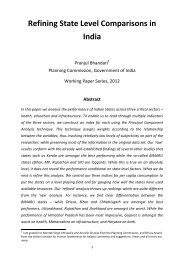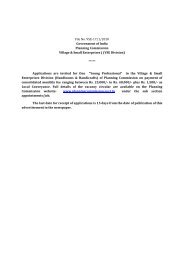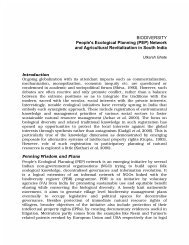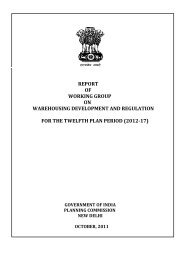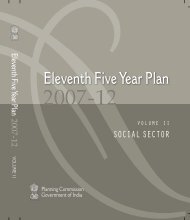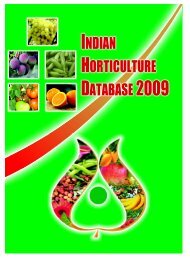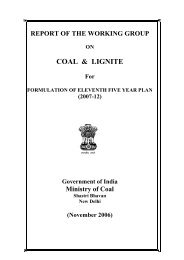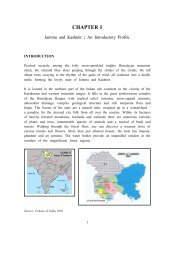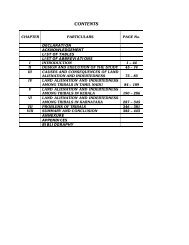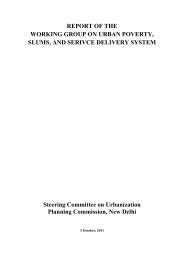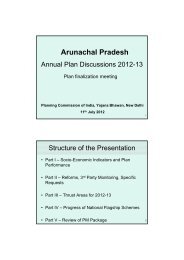Approach Paper for the Twelfth Five Year Plan - of Planning ...
Approach Paper for the Twelfth Five Year Plan - of Planning ...
Approach Paper for the Twelfth Five Year Plan - of Planning ...
Create successful ePaper yourself
Turn your PDF publications into a flip-book with our unique Google optimized e-Paper software.
46 <strong>Approach</strong> to <strong>the</strong> <strong>Twelfth</strong> <strong>Five</strong> <strong>Year</strong> <strong>Plan</strong><br />
5.5 Over <strong>the</strong> last several years, many rural habitations have been provided drinking water supply.<br />
However, <strong>the</strong> number <strong>of</strong> ‘slipped back’ habitations has increased every year because <strong>the</strong> same aquifer is<br />
also being tapped <strong>for</strong> irrigation. This has also led to wetlands and rivers drying up due to reduction in<br />
base flows, which had earlier sustained <strong>the</strong>m. The lowering <strong>of</strong> water tables has also caused, in many cases,<br />
contamination with arsenic, fluoride and o<strong>the</strong>r harmful substances.<br />
5.6 Water quality issues also arise due to chemical pollution through excessive fertiliser use and reckless<br />
dumping <strong>of</strong> untreated waste into our rivers. Only about 30 per cent <strong>of</strong> <strong>the</strong> total sewage generated in <strong>the</strong><br />
country is actually treated be<strong>for</strong>e being dumped into available water bodies.<br />
Maintenance <strong>of</strong> Surface Water Bodies<br />
5.7 We have over a million water bodies comprising <strong>of</strong> lakes, reservoirs and tanks. Their storage capacity<br />
has been eroded by poor maintenance and siltation, as well as o<strong>the</strong>r <strong>for</strong>ms <strong>of</strong> degradation, including<br />
invasion <strong>of</strong> alien water flora. Concerted ef<strong>for</strong>ts are needed to engage in <strong>the</strong> process <strong>of</strong> de-siltation and<br />
restitution <strong>of</strong> <strong>the</strong>se water bodies through treatment <strong>of</strong> <strong>the</strong>ir catchment areas so that <strong>the</strong>y can play <strong>the</strong><br />
fruitful purpose <strong>of</strong> providing capacity to store rainwater, water <strong>for</strong> drinking and o<strong>the</strong>r purposes and<br />
lend <strong>the</strong>mselves to fisheries. Ground water management needs to be promoted in a sustainable manner<br />
to increase productivity <strong>of</strong> land especially in Eastern and North eastern region where ample untapped<br />
ground water resources are available.<br />
Ground Water Management<br />
5.8 Ground water will continue to be a major resource <strong>for</strong> both irrigation and drinking purposes. It is<br />
vital to ensure that this resource is used in a sustainable manner. For this we must greatly expand <strong>the</strong> scope<br />
<strong>of</strong> rainwater harvesting and ground water recharge. Preliminary studies suggest that <strong>the</strong> extent <strong>of</strong> recharge<br />
that is possible with <strong>the</strong> existing precipitation is extremely high in <strong>the</strong> alluvial plains where <strong>the</strong> rates <strong>of</strong><br />
recharge are high. In <strong>the</strong> more rocky areas <strong>of</strong> Central India, where recharge rates are lower, rainwater<br />
harvesting and ground water recharge needs to be supplemented by <strong>the</strong> creation <strong>of</strong> rain-fed small-sized<br />
reservoir/water bodies, including farm ponds and dug wells to impound rainwater. This needs to be done<br />
by converging <strong>the</strong> MGNREGA with <strong>the</strong> Integrated Watershed Management Programme.<br />
Aquifer Mapping<br />
5.9 Since groundwater is <strong>the</strong> main source <strong>of</strong> water in India, special emphasis is needed on obtaining<br />
an accurate picture <strong>of</strong> groundwater resources, including a comprehensive mapping <strong>of</strong> our aquifers at<br />
a watershed scale, with <strong>the</strong>ir storage and transmission characteristics. Our current network <strong>of</strong> around<br />
60,000 observation wells is completely inadequate given <strong>the</strong> explosive rise in groundwater use in recent<br />
years through nearly 30 million groundwater structures. During <strong>the</strong> <strong>Twelfth</strong> <strong>Plan</strong>, we need to move from<br />
a ratio <strong>of</strong> 1: 500 at present towards a ratio <strong>of</strong> at least 1:100 between observation wells and groundwater<br />
use structures so that we gain a more accurate idea <strong>of</strong> actual groundwater use.<br />
Stakeholder Aquifer Management<br />
5.10 Based on <strong>the</strong> aquifer mapping exercise, we need to develop sustainable groundwater management<br />
plans <strong>for</strong> each aquifer. This requires action on <strong>the</strong> ground involving partnerships <strong>of</strong> stakeholders at <strong>the</strong><br />
village-level with hydro-geologists and social mobilizers who would guide collective sharing and sequential<br />
use <strong>of</strong> groundwater based on a careful understanding <strong>of</strong> <strong>the</strong> storage and transmission characteristics <strong>of</strong><br />
different aquifers in each <strong>of</strong> <strong>the</strong> hydro-geological settings outlined in <strong>the</strong> MTA <strong>of</strong> <strong>the</strong> Eleventh <strong>Plan</strong>.



